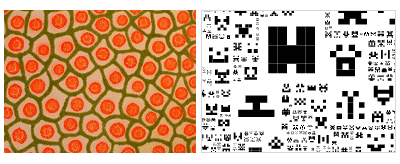
In David Szafranski's paintings, a group of which were linked to here, dataisnature sees some biological and mathematical underpinnings: Itís the human equivalent of a Diffusion Aggregation Limitation system - whereby particles in solution diffuse randomly until they move near to a piece of solid structure, at which point they come out of solution and form part of the aggregate, resulting in dendritic structures. All of the works have a similar quality and evoke the idea of the human-computer in repetitive sub-routines crystallizing the work into existence. To illustrate the human-computer connection, DIN pairs a detail of a Szafranski painting with a section of a computer-generated drawing by Jared Tarbell (reproduced above). Continuing the conversation and emphasizing the links between "cyber" and "natural" diffusion models, Szafranski, no slouch in the computational department as well being a kick ass painter, has posted a seductive animated GIF [1 MB .GIF] that applies some of the principles of growth and space-filling DIN mentions.
The actual physical makeup of the paintings, though, in contrast to the ethereal GIF and DIN's elegant theory, suggests a more problematic relationship to science. Made of glue, spray paint, and modeling store synthetic grass, in semi-stable combinations certain to give art world painting fetishists fits, the canvases may evoke principles of fractal orderliness on a compositional level, but materially they revel in decay and punk anarchy: the mien of safety pins through the cheek rather than white lab coats.
David Szafranski's are great. Thanks for the link.
I wonder what the appeal is for animated Gifs in comparison to Flash though ...
cheers,
Mark
Animated GIFs are open source. They are low bandwidth. They play in your browser without downloading special players that pester you to update. They are easy to make, reverse engineer and share. They are not dependent on the software of a company that criminally prosecutes people for intellectual property disputes, and sells bloatware.
|
In David Szafranski's paintings, a group of which were linked to here, dataisnature sees some biological and mathematical underpinnings: To illustrate the human-computer connection, DIN pairs a detail of a Szafranski painting with a section of a computer-generated drawing by Jared Tarbell (reproduced above). Continuing the conversation and emphasizing the links between "cyber" and "natural" diffusion models, Szafranski, no slouch in the computational department as well being a kick ass painter, has posted a seductive animated GIF [1 MB .GIF] that applies some of the principles of growth and space-filling DIN mentions.
The actual physical makeup of the paintings, though, in contrast to the ethereal GIF and DIN's elegant theory, suggests a more problematic relationship to science. Made of glue, spray paint, and modeling store synthetic grass, in semi-stable combinations certain to give art world painting fetishists fits, the canvases may evoke principles of fractal orderliness on a compositional level, but materially they revel in decay and punk anarchy: the mien of safety pins through the cheek rather than white lab coats.
- tom moody 8-12-2006 10:04 am
David Szafranski's are great. Thanks for the link.
I wonder what the appeal is for animated Gifs in comparison to Flash though ...
cheers,
Mark
- anonymous (guest) 8-16-2006 7:04 am
Animated GIFs are open source. They are low bandwidth. They play in your browser without downloading special players that pester you to update. They are easy to make, reverse engineer and share. They are not dependent on the software of a company that criminally prosecutes people for intellectual property disputes, and sells bloatware.
- tom moody 8-16-2006 8:01 am